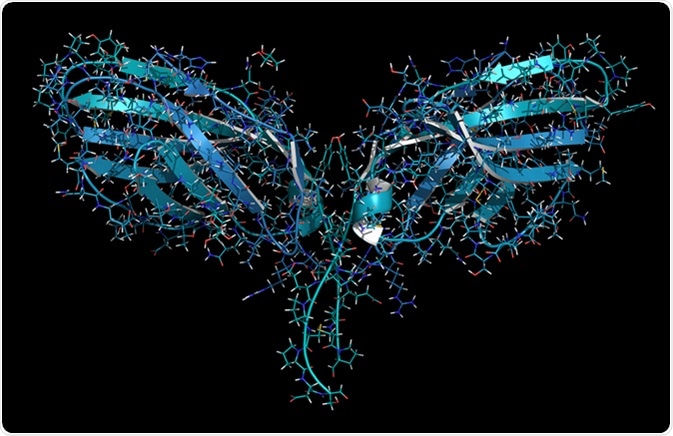Cytotoxic T-lymphocyte-associated protein 4 (CTLA-4), also known as CD152, is a protein receptor and an immunogenic checkpoint that functions as a down-regulator of immune system responses. The gene responsible for encoding this protein is found on chromosome 2 in humans.
CTLA-4 expression occurs on CD4+ and CD8+ T cells almost exclusively, and plays a critical role in their homeostasis. By binding to CD80/86 on antigen-presenting cells (APCs), CTLA-4 is able to effectively block the co-stimulation that would otherwise occur between APCs and T cells.

CTLA-4 (Cytotoxic T-lymphocyte-associated protein 4, CD152) protein. CTLA4 blocking antibodies are used in cancer therapy (immune checkpoint blockade therapy). Image Credit: molekuul_be / Shutterstock
The parts of this protein consist of a cytoplasmic tail, a transmembrane domain and an extracellular V domain. There has been the characterization of varying isoforms, such as a soluble isoform, which functions as a monomer, and a membrane-bound isoform that exists as a homodimer with a disulfide interconnecting bond. CTLA-4’s intracellular domain has no catalytic activity that is intrinsic to it, but consists of a YVKM motif. This motif is capable of binding PP2A, SHP-2, and PI3K.
While the importance of PI3K binding is unclear, the inhibitory effect of CTLA-4 on T cell responses appears to be mediated via the PP2A and SHP-2 dephosphorylation of the T cell receptor’s (TCR) proximal signaling proteins, such as LAT and CD3.
CTLA-4 and T Cells
Throughout our lives we will face a wide array of pathogens that are unknown to our immune systems. In order to put up a good fight against these biological warriors, our immune system generates its own army in the form of a large T cell receptor repertoire with the ability to recognize a plethora of pathogens. However, sometimes our own army is so strong that our soldiers (i.e. our T cells) may turn on each other and become self-reactive. Hence, here lies the need for controlling these rogue cells.
The thymus plays an important role in attempting to avert the generation of self-reactive T cells, but it is not done 100%, thereby leading to some self-reactive T cells entering the peripheral circulation. Once in the peripheral pool, CTLA-4 steps in to take care of these self-reactive T cells. T-regulatory T cells are the major cell types that express CTLA-4.
In order to work, CTLA-4 causes a directly antagonistic effect on the CD28 co-stimulatory receptor. The importance of both of these receptors have been elucidated in experimental models where mice with genetic CTLA-4 deficits and resultant excessive CD28 stimulation were susceptible to profound autoimmune disease and immune system dysregulation.
JCI's Conversations with Giants in Medicine: James Allison
CTLA-4 in Drug Therapy
Scientists discovered that CTLA-4 is capable of retaining biological activity in its soluble form. This groundbreaking discovery enabled the engineering of drugs, such as CTLA-4 fusion protein, to treat autoimmune diseases among other medical conditions.
Further Reading